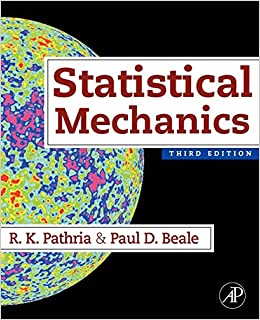(a) Using the thermodynamic relation [ C_{P}-C_{mathrm{V}}=T(partial P / partial T)_{mathrm{V}}(partial V / partial T)_{P}=-T(partial P /...
Question:
(a) Using the thermodynamic relation
\[
C_{P}-C_{\mathrm{V}}=T(\partial P / \partial T)_{\mathrm{V}}(\partial V / \partial T)_{P}=-T(\partial P / \partial T)_{\mathrm{V}}^{2} /(\partial P / \partial V)_{T}
\]
and the equation of state (10.3.9), we get
\[
\frac{C_{P}-C_{\mathrm{V}}}{N k}=-\frac{T(\partial P / \partial T)_{\mathrm{v}}^{2}}{k(\partial P / \partial \mathrm{v})_{T}}=-\frac{T\{k /(\mathrm{v}-b)\}^{2}}{k\left\{-k T /\left(\mathrm{v}-b^{2} \right)+2 a / \mathrm{v}^{3} \right\}}=\frac{1}{1-2 a(\mathrm{v}-b)^{2} / k T \mathrm{v}^{3}}
\]
(b) In view of the thermodynamic relation
\[
T d S=C_{\mathrm{V}} d T+T(\partial P / \partial T)_{\mathrm{V}} d V
\]
and the equation of state (10.3.9), an adiabatic process is characterized by the fact that
\[
C_{\mathrm{V}} d T+N k T(\mathrm{v}-b)^{-1} d \mathrm{v}=0
\]
Integrating this result, under the assumption that \(C_{\mathrm{V}}=\) const., we get
\[
T^{C_{\mathrm{V}} / N k}(\mathrm{v}-b)=\text { const. }
\]
(c) For this process we evaluate the Joule coefficient
\[
\left(\frac{\partial T}{\partial V} \right)_{U}=\frac{(\partial U / \partial V)_{T}}{(\partial U / \partial T)_{\mathrm{V}}}=-\frac{T(\partial P / \partial T)_{\mathrm{V}}-P}{C_{\mathrm{V}}}=-\frac{a / \mathrm{v}^{2}}{C_{\mathrm{V}}}=-\frac{N^{2} a}{C_{\mathrm{V}} V^{2}}
\]
Now integrating from state 1 to state 2, we readily obtain the desired result.
Step by Step Answer:






